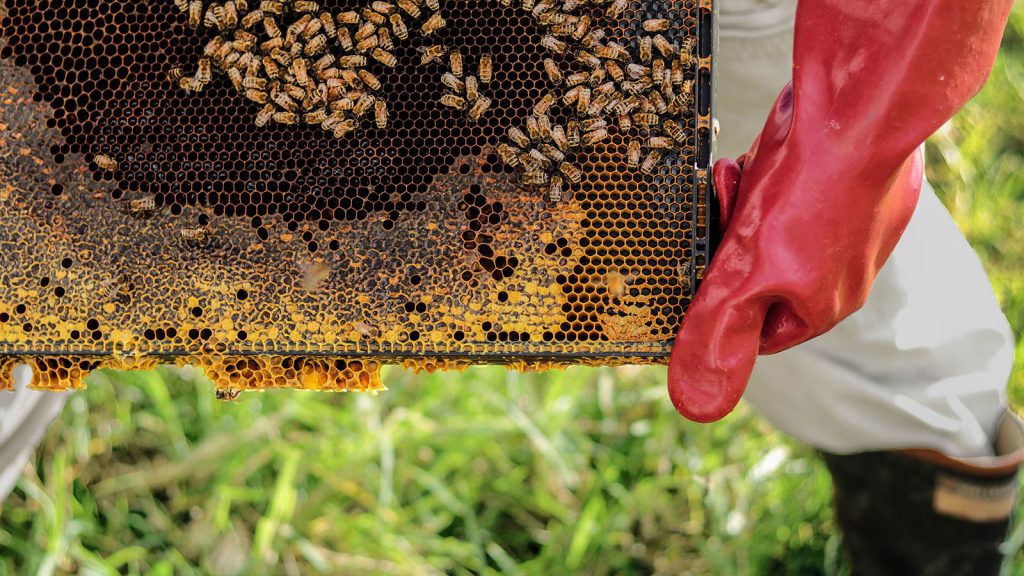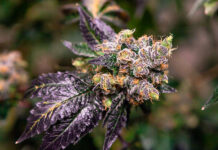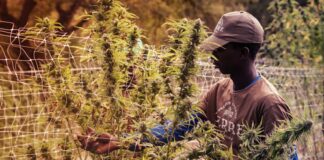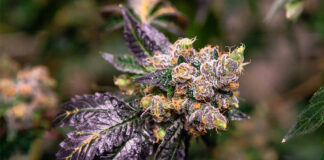For thousands of years, honey has been making quite the name for itself.
Touted for a long list of reputed health benefits — from natural antibiotic and wound healer to helping alleviate gastrointestinal distress and fighting fungus and viruses — honey is one impressive food.
Though the specific benefits vary, cannabis is no slouch in regards to its own long list of possible medicinal uses. In fact, it was originally used for its health benefits, such as anti-nausea medicine, rather than for its intoxicating effects.
But there are lots of superfoods. Why pair these particular two — honey and cannabis — to create what is becoming known as CBD honey?
“Honey is delicious and extremely shelf-stable,” said Katie Stem, CEO and co-founder of Oregon-based Peak Extracts, an extraction company that makes its own chocolate edibles and cannabis herbal rub.
Stem, who has a background in laboratory science and Chinese medicine, said it’s a highly effective natural preservative, which might be part of its appeal for edibles manufacturers. In fact, Egyptian tombs excavated by archaeologists have revealed completely preserved pots of honey that are still edible.
“Raw honey is the oldest carrier of natural medicine, as it contains important pollens and plant extracts that help with inflammation and allergies,” said Seth Nyer, co-founder of Bee Delightful in Austin, Texas. “We’ve been evolving with honey for thousands of years. It is a pre-digested food, which means as humans we can absorb it topically, sublingually and through many of our major digestive organs, which all benefit from the antioxidants.”
What Exactly Is CBD Honey?
Honey infused with either hemp, marijuana or cannabidiol (CBD) isolate are called CBD honey. The idea is that the benefits of cannabinoids such as CBD are combined with the benefits of honey to create a superfood hybrid of sorts.
There are several processes that can make CBD honey, but they can be divided into two main categories, according to Stem: extraction into honey or direct infusion.
Direct infusion involves grinding up a cannabis plant, mixing it into honey and heating them until the cannabinoids dissolve.
The extraction method can be done with ethanol, hydrocarbon (butane) or carbon dioxide, according to Stem. Regardless of which of the three is used, the cannabinoids are pulled out during the process. Stem said her preference is to use carbon dioxide as the extraction method because it is safer and has less environmental impact than hydrocarbon — which must be incinerated. Once extraction is complete, the extract is then dissolved into the honey.
There is a third, more DIY method, akin to direct infusion. But instead of heating on a stove, sunlight is used as the heat source. Stem said that with this method, ground cannabis is mixed in a jar of honey and left on a windowsill for three to six months. However, this method requires much patience, plus it creates a very inconsistent end product.
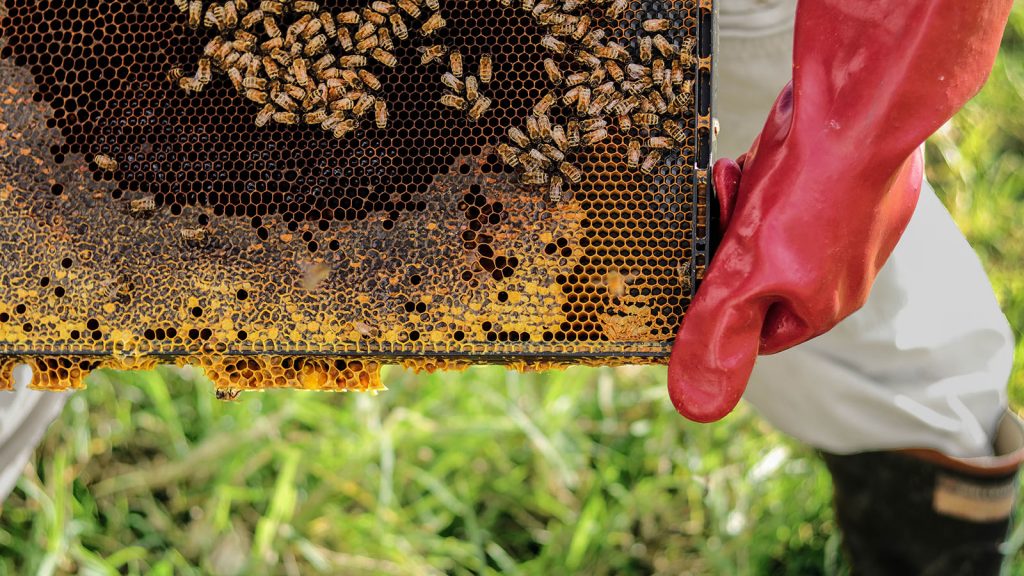
CBD honey can be made by direct infusion or extraction. For products made by direct infusion, cannabis is ground into honey, and the mixture is heated until the cannabinoids dissolve. Extraction involves a solvent such as ethanol or butane.
Consumers looking for CBD honey don’t have to look very far. From dispensaries to natural foods stores and online retailers, these products are everywhere and with varying degrees of quality. Adding to the overwhelming number of products is the legal gray area. According to Stem, hemp is currently legal in the United States as long as it doesn’t contain more than 0.3 percent THC. So anything made from this, including CBD honey, would technically be legal. However, the act of processing the hemp into other forms may actually raise that original amount of THC.
“It’s really gray right now,” she said. “You can still get a significant dose of THC from something that was 0.3 THC in its hemp state.”
Though the 2018 Farm Bill just signed into law by President Donald Trump could clarify things on some level by federally legalizing industrial hemp cultivation. Cannabis remains a controlled substance federally.
In terms of finding a high-quality product, Stem said the most important thing is making sure it is tested for potency, pesticides, and heavy metals. A company offering this information on its website or when asked is always a good sign. Secondly, Stem said that consumers should also check the label or ask the company if the product is made with activated CBD, which is supposed to be the most beneficial to the body.
Not all companies are using the same quality standards to make CBD honey. So a bit of research is in order for consumers looking for a high-quality product. Many CBD honey makers recommend using raw, or unheated, over processed (heated) honey because heat can degrade components like digestive enzymes in the honey that are believed by some to benefit digestion in humans.
“It is important to know both where the honey and the CBD is coming from,” said Jessica Gonzalez, of Happy Organics in Merced, California. “I would suggest getting a raw honey because it has not been heated or processed – processing and heating honey kills and removes all of the healthy properties found in honey.”
Gonzalez, who is a beekeeper herself, recommends buying from beekeepers.
“Knowing the beekeeper is important because you will know exactly where your honey came from,” Gonzalez said. “We start from the hive.”
Why CBD Honey Is Trending
It should come as little surprise that CBD honey has been gaining notice with consumers.
I’m gonna make agua de jamaica with CBD honey and y’all can’t stop me
— lorena cupcake (@lorenacupcake) December 19, 2018
According to Greg Shoenfeld, vice president of operations for BDS Analytics, sales of CBD-infused honey in Arizona, California, Colorado, and Oregon generated $1.47 million with 139,000 units sold between January and October 2018. Though this is a small fraction of the $685 million in edibles sales across the four states over the same period, the category has grown 46 percent from January to October 2018.
The apparent popularity of CBD honey doesn’t have one simple cause. For some companies, like Mana Artisan Botanics, it just seemed like a good idea.
“One of the reasons we decided to highlight honey is because we have one of the rarest honeys in the world with our Lehua honey,” said Steve Sakala, CEO and co-founder of the Hawaii-based company that makes hemp body products, tinctures, and honey. Lehua honey comes from the Hawaiian tree of the same name. “It was part of our mission to highlight Hawaiian agriculture products in addition to making high-grade wellness products.
Sakala explained that honey could serve as an entry point product to first-time users and older generations, offering a simple way to infuse teas or beverages with a product they’re comfortable using. He added that they also want to help the bee population by supporting organic beekeepers — an idea shared by other companies, including Happy Organics.
“We are beekeepers,” Gonzalez said. “We put our bees first and only take when the hive is producing in excess. Our small apiary allows us to help both the environment and provide local, sustainable honey.”
Nyer of Bee Delightful agrees.
“We rescue bees in Texas and believe everyone should be aware that there is a bee crisis,” said Nyer. “Bees are critical to human beings. They are responsible for pollinating a significant amount of our produce and we rely heavily on them for the pollination of our food. If we don’t all support products that are doing their part to help the bees, we will soon feel the effects of their decline.”
Of course cannabis legalization in many states has likely played a role as well.
“When we started making our infused honey, microdosed edibles like ours were not as popular as their high-dosed counterparts,” said Corey Thomas, founder of California-based Honey Pot, which makes cannabis-infused honey containing both CBD and THC. “There is a new cannabis consumer in California since the passing of Proposition 64, those consumers are looking for entry-level edibles, doses they can control and ingredients like ours to infuse their own edibles at home.”
Back to the original point, the potential health benefits of combining honey and cannabis can’t be ignored.
THC bath salts w CBD honey has cured my body aches 💕
— almond barber (@rektravioli) December 20, 2018
Nyer said honey has anti-inflammatory, anti-microbial, anti-viral, anti-fungal and antioxidant benefits. And he added that CBD has neuroprotective, anti-inflammatory and antioxidant benefits. It may help with anxiety, stress, focus, pain, inflammation, sleep and many neurological disorders, he said. Of course, many reported benefits of cannabis are anecdotal. There are a lack of studies due to its current status as a federal controlled substance.
“Because there are not long-term clinical trials on cannabis and its derivatives, people rely on anecdotal recommendations from family and friends,” Nyer said. “A lot of people who have not been able to find natural remedies for pain, anxiety and depression have found relief with CBD.”


